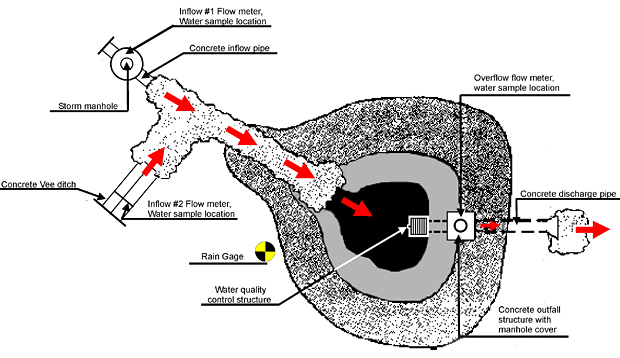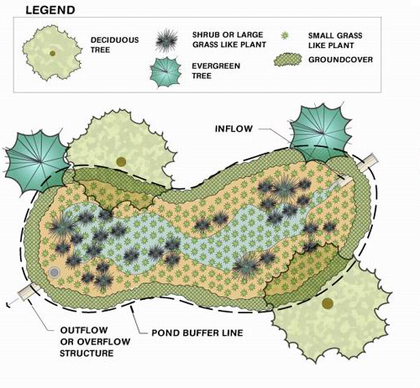
Detention ponds are a
Best Management Practice (BMP) implemented to reduce peak runoff
rates and control water quantity. This sustainable strategy may be
used as a means to avoid the expense and environmental impact common
with conventional stormwater management systems, such as drain
inlets and culverts, which typically deliver runoff to adjacent
watersheds without any filtration. Detention ponds are an effective
method to remove sediment and pollutants from stormwater as well as
reduce peak runoff rates in an effort to prevent flooding and
erosion of local waterways. If implemented with the overall
landscape design, cost of detention ponds can be kept to a minimum
since construction methods and materials are similar to standard
landscaping practices.
Two types of detention ponds, wet and dry, may be implemented
based on the desired results. Wet detention ponds have a permanent
pool of water, while dry detention ponds detain water for a
predetermined amount of time based on the design and size. Both of
these methods contain the same basic elements: a water detention
area and an outlet device which slows the runoff to predevelopment
rates.
Wet detention ponds have a permanent pool of water in order to
allow gradual removal of suspended solids through sedimentation and
biological uptake. In addition to superior water quality control as
compared to dry retention ponds, wet detention ponds may also be
designed to add aesthetic value or serve as an AT/FP buffer.

Figure 1. Wet detention pond design detail
Applicability of a wet detention pond will vary depending on site
specific characteristics. Highly developed areas may not be feasible
due to the lack of available land required for the ponding area
however wet and dry detention ponds may be implemented as an
end-of-pipe treatment method. Arid climates may also exclude this
stormwater mitigation method because of the need for a constant
presence of water.
 In sharp contrast to wet detention ponds, dry detention ponds
typically retain stormwater runoff in the range of twelve to
forty-eight hours. This stormwater mitigation method is effective
for flood control and erosion prevention of local waterways;
however, it does not have soluble pollutant removal properties equal
to wet detention ponds due to the limited amount of time water is
detained. Small, separate ponding areas may be employed at the inlet
and/or outlet of the detention pond to increase the runoff storage
capacity as well as the pollutant and sediment removal capability. In sharp contrast to wet detention ponds, dry detention ponds
typically retain stormwater runoff in the range of twelve to
forty-eight hours. This stormwater mitigation method is effective
for flood control and erosion prevention of local waterways;
however, it does not have soluble pollutant removal properties equal
to wet detention ponds due to the limited amount of time water is
detained. Small, separate ponding areas may be employed at the inlet
and/or outlet of the detention pond to increase the runoff storage
capacity as well as the pollutant and sediment removal capability.
Dry detention ponds have successfully been used to control
stormwater runoff in a variety of locations across the world.
Sufficient space for the detention pond and the size of the drainage
area to be controlled are the most important deciding factors. Both
dry and wet detention ponds have been shown to increase stormwater
temperatures, therefore, careful consideration needs to be taken if
the pond will be feeding into a cold water habitat.
Figure 2. Dry detention pond design detail
Both wet and dry detention ponds are potential strategies to
achieve the intent of LEED SS Credit
6.1 and SS Credit
6.2. Refer to the
LEED Guidance
section for specific requirements.

|

